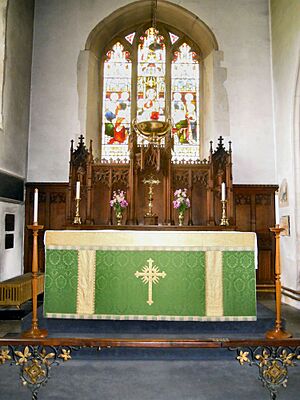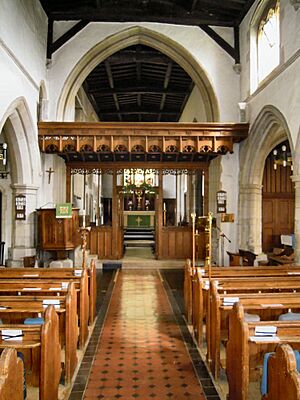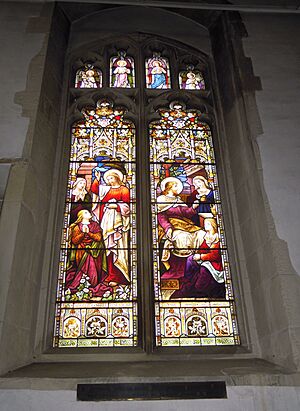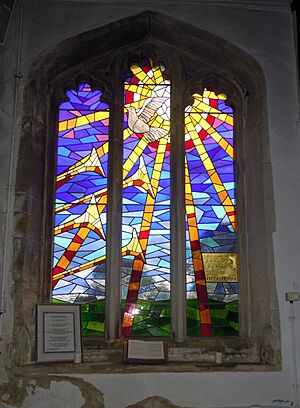St Mary's Church, Potton facts for kids
Quick facts for kids St Mary's Church, Potton |
|
|---|---|
| The Parish Church of St Mary, Potton | |
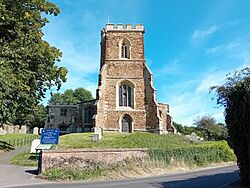 |
|
| Country | England |
| Denomination | Church of England |
| Website | http://www.pottonparishchurch.org.uk |
| History | |
| Status | Parish church |
| Dedication | St Mary |
| Architecture | |
| Functional status | Active |
| Administration | |
| Deanery | Biggleswade |
| Archdeaconry | Bedford |
| Diocese | St Albans |
| Province | Canterbury |
The Parish Church of St Mary is a special church for the town of Potton in Bedfordshire, England. It belongs to the Church of England, which is a Christian church. This church has been a very important historical building since 1966. It is part of the Diocese of St Albans.
Contents
The Church's History and Look

People have worshipped on this spot for a very long time. There has been a church here since the 11th century. The building you see today started in the 13th century. Over the years, more parts were added in the 14th, 15th, and early 16th centuries.
The church is built from cobblestones and ironstone. It also has smooth stone called ashlar for details. You can see different types of walls, some flat and some with a castle-like top.
Main Parts of the Church
The church has several important sections. These include the chancel (the area near the altar), a South chapel, and the nave (the main part where people sit). It also has a North transept, which is like an arm of the church. There are North and South aisles, a North porch, and a tall West tower.
The chancel was first built in the 13th century. It was updated in the 15th century. The East window in the chancel was added in the 19th century. It has three sections.
The South chapel was built in the 16th century. It has three windows that let in light. There used to be a small room called a vestry on the north side. This room was built in the 15th century but was taken down in the 16th century.
The nave, where the churchgoers sit, has parts from the 13th century. Most of it dates to the 14th century. It has rows of arches on both sides. Above these arches, there is a clerestory. This is a row of windows that bring light into the main part of the church. These windows were added in the 15th century.
The North transept is from the 13th century. It has a large window on its east side. The North and South aisles were built in the 14th century and updated in the 15th century. The North porch, which is the entrance, was added in the 15th century. It even has a room above it.
The West Tower
The tall West tower was built in the 15th century. It has a round staircase on one side. On the outside of the tower, you can still see where a stone lamp holder once was. The top part of the tower, called the belfry, has windows on all sides. This is where the church bells would be.
The roofs of the church were repaired in the 19th century. However, they still have much of their original wooden beams. Some of these beams are from the 14th century, and others are from the 15th and 16th centuries. The wooden benches, called pews, are from the 19th century. The round baptismal font, used for baptisms, is very old, but its exact age is not known.
The church was carefully restored in 1889. This work was done by architects named Somers Clarke and J. T. Micklethwaite.
Beautiful Stained Glass Windows
The stained glass windows in St Mary's Church are mostly from the Victorian era. The large East window has three sections. It shows a scene of the Last Supper. This window was put in place in 1888 to remember James Wagstaff.
The two windows in the West part of the church are from the 15th century. The larger one was installed in 1865. It remembers Rev George Bidwell. This window shows important moments from the life of Jesus, like his birth, his crucifixion, and his resurrection. It also shows Jesus and Mary Magdalene in the Garden of Gethsemane.
Another stained glass window is in the north transept. It was put in in 1892. This window remembers Elizabeth Wagstaff, who was James Wagstaff's wife. It shows Jesus talking with a woman at a well.
One of the most colorful windows is in the South aisle. It was designed by Carl Russell and installed in 1994. This modern window shows the Holy Spirit as a dove. It flies out from sun rays above angels' trumpets. This window celebrates 900 years of worship at St Mary's Church.


